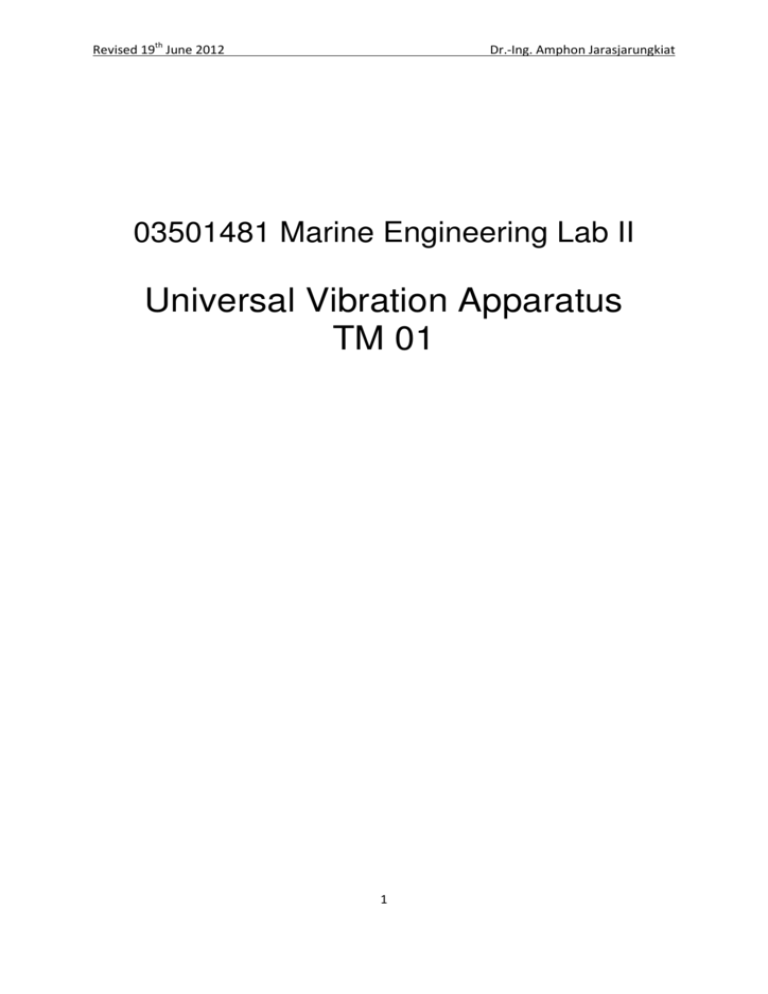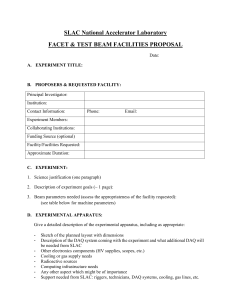
Revised 19th June 2012
Dr.-Ing. Amphon Jarasjarungkiat
03501481 Marine Engineering Lab II
Universal Vibration Apparatus
TM 01
1
Revised 19th June 2012
Dr.-Ing. Amphon Jarasjarungkiat
CONTENTS
INTRODUCTION
1
GENERAL DESCRIPTION OF THE APPARATUS
1
Portal Frame
1
List of Components
3
EXPERIMENTS
Experiment 9: Transverse Vibration of a Beam with One or More Bodies Attached
4
Experiment 10: Forced Vibration of a Rigid Body - Spring System with Negligible Damping
10
Experiment 11: Free Damped Vibrations of a Rigid Body - Spring System
10
Experiment 12: Forced Damped Vibration of a Rigid Body - Spring System
14
References
16
APPENDIX: Data Tables
17
2
Revised 19th June 2012
Dr.-Ing. Amphon Jarasjarungkiat
1. INTRODUCTION
The TM01 Universal Vibration Apparatus enables students to perform a
comprehensive range of vibration experiments with the minimum amount of
assembly time and the maximum adaptability. The experiments lead the student
through the basics of vibration theory by, initially, very simple experiments which
make way for those of a more extensive nature as experimental aptitude increases.
This manual primarily give details of the apparatus required and the experimental
techniques involved for each experiment in turn. Each experiment starts with an
'Introduction' dealing with the purpose and basic theory involved. Further sections
detail the apparatus and experimental method with reference to diagrams included in
the text. Finally, the form of calculations and results is given.
2. GENERAL DESCRIPTION OF THE APPARATUS
Figure 1 TM0l Apparatus
Portal Frame
The apparatus shown in Figure 1, consists of a basic portal frame, robustly
constructed from square, rolled hollow section, vertical uprights and double channel
horizontal members. The frame mounts on four castors for ease of mobility. Screw
jacks allow the weight of the frame to transfer to the floor during experiments, which
3
Revised 19th June 2012
Dr.-Ing. Amphon Jarasjarungkiat
enables the entire rig to be leveled prior to the experimental work and guarantees
rigidity.
The frame has been fully machined for experiments. A cupboard is fitted at
the front to houses all the components when they are not in use.
Figure 2 Front Panel and Rear Panel of Control Box
A d.c. motor driven exciter is used for all forced vibrations experiments
powered by a control unit. This combination comprises of a control box and d.c.
motor, which provides precision speed control of the motor up to 3000 rev/min. This
motor drives the two unbalance discs to provide force excitation to the member
attached to this exciter assembly. The front panel of the unit contains a speed control
and a period/frequency meter. The front panel also includes a start/stop switch for
drum recorder and a low speed/high speed selection switch for this recorder. The
individual power on/off switches for two different kinds of sensor and plotter pens are
also included.
The back panel includes power sockets for mains input, power output to d.c.
motor, power output to drum recorder motor, 2 sensor connection sockets labeled
sensor names, 2 connectors for 2 pens and PC connection to AiD card inside PC.
4
Revised 19th June 2012
Dr.-Ing. Amphon Jarasjarungkiat
Part Number
Description
Relevant experiment
B1
B2
B3
B4
B5
B6
B7
pendulum sub-frame(cross beam)
Simple pendulum-Wood ball
B3 Simple pendulum-Steel ball
Kater(adjustable) pendulum
Wooden compound pendulum
Simple bob pendulum
Bifillar suspension
1,2,3,4,5
1
1
4
3
2,3
5
C1
C2
C3
Top adjusting assembly(Spring)
6,10,11,12
Guide bush assembly
Loading platform
6
6
D1
D2
D3
D4
D5
D6
D7
D8
Pivot mounting
Damper assembly
Damper bracket
Out-Of-Balance disk
Beam support
Stylus and support
Drum Plotter
pivot support for stylus
9,10,11,12
10,11,12
10,11,12
10,11,12
10,11,12
10,11,12
10,11,12
14
Pivot mounting with lateral movement
Flexible Beam
Exciter motor
9
9
9
9
9,10,12
H1
H2
Rotor (254mm diameter)
Rotor and addition
7,9
7
I1
Bracket
7
S1
S4
M1
LDT (Linear Displacement Transducer)
Optical Sensor
Magnetic Stand to hold optical sensor
E1
E2
E3
E6
E11
Damper Support
Support for Linear Displacement Transducer
Table 1 List of components
5
Revised 19th June 2012
Dr.-Ing. Amphon Jarasjarungkiat
3. EXPERIMENTS
Experiment 9: Transverse Vibration of a Beam with One or More Bodies
Attached
lntroduction
The frequency of transverse vibrations of a beam with bodies attached is
identical to the critical (whirling) speed of a shaft of the same stiffness as the beam,
carrying rotors of masses which correspond to those of the bodies on the beam.
One has to think in terms of small size rotors, otherwise gyroscopic effects are
involved.
In the case of a beam with just one body attached, the basic theory is the same as
that in Experiment 6. For a beam with two or more bodies attached, other methods
can determine the frequency of free transverse vibrations. Examples are as follows:
1. Rayleigh or energy method (gives good results);
2. Dunkerley equation (only approximate, but quite adequate);
3. Rigorous (accurate) analysis (arduous);
4. Experimental analysis, using the equipment described below, (fairly simple quick)
Apparatus
The basic apparatus for this experiment is in Figure 20. A bar of steel of
rectangular cross-section (E6) is supported at each end. The left-hand support (D1)
pivots in two ball bearings in a housing located on the inside face of the vertical
frame member.
Figure 20 Set-up for Experiment 9
The right-hand support consists of two roller bearings (E1), which are free to
move in a guide block located on the inside face. At the centre of the beam bolt a
small motor driving two 'out-of-balance' discs (Excitor Motor and Speed Control unit).
Connect the motor via leads to the precision speed control unit, which applies a wide
range of exciting frequencies to the beam.
6
Revised 19th June 2012
Dr.-Ing. Amphon Jarasjarungkiat
Clockwise rotation of the control knob on the speed control unit will increase the
speed of the motor - thus increasing the out-of-balance rotating force produced by
the unbalanced discs. As the speed increases as indicated by the speed meter on
the control unit, the beam begins to vibrate transversely. Over a discrete band of
frequencies increasingly larger amplitudes of vibration are produced which reach a
peak at a frequency corresponding to the frequency of free natural transverse
vibration of the system, i.e. beam plus added components.
Part A: Transverse Vibration of a Beam
Procedure
Suspend bodies of different size mass, m, below the motor. For each mass m,
adjust the speed control until the beam vibrates at its natural frequency. In order to
determine accurately the exact value on the speed meter, it is expedient to take the
beam through the range of excessive amplitudes several times, noting the limits of
the range. From these, we can locate the frequency at which the amplitude and
resultant noise appears greatest. Record your observations in Table 12.
Table 12 Results
Mass m (kg)
3.95
Frequency ݂ (Hz)
݂ଶ
1
݂ଶ
4.35
5.95
7.15
8.35
Results
A graph of (1/f2) to a base of m gives a straight line, as in Figure 21.
The intercept on the vertical axis is equal to (1/f2b)
݂ = Natural frequency of the system, i.e. beam plus added components.
݂ = Natural frequency of the beam by itself.
Dunkerley's equation is applicable to this situation, and is given by
1
1
1
= ଶ+ ଶ
ଶ
݂
݂ଵ
݂
Here, f1 stands for the natural frequency of a corresponding light beam with mass m
attached. Clearly when m=0, f1=infinity, f = fb
Evaluate and compare with the theoretical value obtained from:
7
Revised 19th June 2012
Dr.-Ing. Amphon Jarasjarungkiat
ߨଶ
ܫܧ
ඨ
݂ =
2 ݉ ܮଷ
where
L
E
I
mo
= Length of the beam (m);
= Modulus of elasticity of material of the beam (N/m2);
= Second moment of area of the beam section:
= Mass of the beam by itself (kg); no masses attached.
Also, from the graph, when the system is not vibrating (period τ = 0) f = infinity and
1/f2 = 0. The corresponding value of mass m is then equal to me, the equivalent mass
of the beam. me =λm0, where λ is a constant.
Determine the value of λ. How does it compare with the generally accepted value of
0.5?
Figure 21 Graph of 1/f2 versus m
Part B: Damped Transverse Vibration of a Beam
Introduction
Damping forces are counteracting forces in a vibration system, which
gradually reduce the motion. Damping occurs in all natural vibration and may be
caused by coulomb friction (rubbing between one solid and another), or viscous
resistance of a fluid as in this experiment on damped transverse vibration of a beam
where a viscous damper is used.
Apparatus
This is shown in Figure 20 (the same set up as for Experiment 9A, but with
certain additions). In this experiment you will require the amplitude of vibration and
phase angle. Fit a damper (D2) and its support (D3) to the beam to create damping.
Use the linear transducer to determine the amplitude and phase angle very
accurately at any exciting frequency.
8
Revised 19th June 2012
Dr.-Ing. Amphon Jarasjarungkiat
Procedure
Allow the speed control unit time to warm-up, then adjust the linear transducer
vertical position so that it reading is zero on computer display. Energise the motor to
produce a definite amplitude at a predetermined frequency. Read the amplitude on
computer display. You may also find the phase angle on computer display. By
following this procedure for a range of frequencies, you can assess the effect of
damping by varying the valve opening of the damper and thus altering the damping
characteristics of the system.
Compare the results obtained with these settings with an undamped condition
(the system minus dashpot). Plot graphs of amplitude and phase angle against the
frequency ratio ω /ωn , i.e. (exciting frequency/natural frequency).
The results, in Tables 13 to 15, show the effect of increasing damping on
amplitude and phase angle. For each damping condition a graph of amplitude
against frequency can be plotted, from which a value for the natural frequency for
each damping condition can be found. Figures 22 and 23 are typical graphs of
amplitude and phase angle plotted against frequency ratio.
Table 13 Results for the case without damping
Disc speed (Hz)
ω /ωn
Phase angle (°)
Max amplitude
(mm.)
Table 14 Results for the case of minimal damping
Disc speed (Hz)
ω /ωn
Phase angle (°)
9
Max amplitude
(mm.)
Revised 19th June 2012
Dr.-Ing. Amphon Jarasjarungkiat
Table 15 Results for the case of maximal damping
Disc speed (Hz)
ω /ωn
Phase angle (°)
10
Max amplitude
(mm.)
Revised 19th June 2012
Dr.-Ing. Amphon Jarasjarungkiat
Figure 22 Comparison of the damping ratio
Figure 23 Comparison of the phase lag
11
Revised 19th June 2012
Dr.-Ing. Amphon Jarasjarungkiat
References
1. Manual for Universal vibration apparatus TM01, Kinetics corporation limited.
2. Thomson W.T., Theory of Vibrations with Applications, 5th Edition, Pearson
Prentice Hall, Inc., 1998.
3. Craig R.R., Kurdila A. J., Fundamental of Structural Dynamics, 2nd Edition,
John Wiley & Sons, Inc., 2006.
16
Revised 19th June 2012
Dr.-Ing. Amphon Jarasjarungkiat
Appendix A
17
Revised 19th June 2012
Dr.-Ing. Amphon Jarasjarungkiat
18
Revised 19th June 2012
Dr.-Ing. Amphon Jarasjarungkiat
19
Revised 19th June 2012
Dr.-Ing. Amphon Jarasjarungkiat
20









